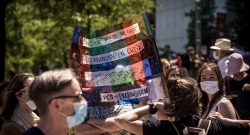Chronicle of a Pandemic
Recovery continues in spite of inflation
The recovery of the live performance sector continued during the third quarter of 2022. Nominal GDP increased 2.8%. Jobs increased 5.3%.
Recovery slowed down amid fifth wave
The GDP growth of the live performance sector stalled during the first quarter of 2021, but employment performed better than other sectors.
Federal budget acknowledges uneven recovery, but leaves much to be desired
The 2022 federal budget provides little new funding for the performing arts sector. But we remain hopeful that the National Recovery Summit will provide another opportunity to address the needs of the industry.
Finding Our Way: National Town Hall Report
On January 25, CAPACOA welcomed members of the performing arts community to share their hopes for the future. Discussions around digital space, social inequity, and the climate crisis led to new discoveries.
Federal government announces new measures for tourism and hard-hit organizations
The federal government announced the Tourism and Hospitality Recovery Program and the Hardest-Hit Business Recovery Program.
No recovery in sight for the performing arts
Despite a gradual easing of public health restrictions in the provinces and territories, performing arts companies, presenters and festivals still showed no signs of economic recovery in the second quarter of 2021.
Vaccination: how do culture goers feel about it?
CAPACOA recently held a fascinating town hall on the theme On the Path to Recovery: Are Mandatory Vaccines for Audiences in the Mix? As a complement to the recap of this discussion, here are recent findings about culture goers’ attitudes regarding vaccination.
On the Path to Recovery: Are Mandatory Vaccines for Audiences in the Mix?
As the performing arts sector opens its doors and welcomes back audience members, performing arts presenters are eager to determine how they can keep patrons safe, but creating safety protocols proves to be a logistical nightmare. One such protocol has been hotly debated – mandatory proof of vaccina...Read More
A major boost for festivals in the 2021 federal budget
The 2021 federal budget provides funding for festivals and for music venues. But questions remain about the level of support for the rest of the live performance sector.
A close-up shot of the live performance domain – May not be suitable for sensitive viewers
New quarterly indicators released today by Statistics Canada provide an accurate measure of the profound impact of the COVID-19 pandemic on the live performance domain.
Online performances remain a valuable alternative for many cultural consumers
More and more cultural consumers have watched and paid for online performances. For these consumers, "free" is a poor value proposition.
Government regulations and uncertainty about demand remain large obstacles for arts organizations
Government regulations were the top obstacle reported by arts, entertainment and recreation organizations, followed by demand-related concerns.
Untold Stories: COVID-19 and Artist Agents
“I don’t want to sugarcoat the truth; my business is very challenged at the moment.” This is what Tara Bailey, an agent dedicated to youth and family programming and owner of the Bailiwick Booking Agency, said in response to my question regarding her agency’s current situation during the pande...Read More
2020: The Year One in Four Arts Worker Lost Their Job
The COVID pandemic took a particularly heavy toll on the arts sector in 2020. One in four arts, entertainment and recreation workers lost their job in 2020, compared to 2019. That’s 114,400 artists, technicians, marketing staff, arts administrators and other cultural workers who could no longer earn...Read More
We Are All In This Together
“We all did a show, all together, from coast to coast in Canada. Now THAT is a first!” - Morgan Myler, co-founder, Live Event Community
Rebuilding Upon More Sustainable and Equitable Foundations
How can the live performance sector recover from the COVID crisis and at the same time foster innovation, resilience, sustainability and equity? It seems like a pretty big order for a sector that was decimated by months of restrictions on live events.
Online cultural offerings satisfy audiences’ cravings… for now
A lot of people enjoyed live-streamed performances since the beginning of the COVID crisis. But they may not continue when venues reopen.
Artists and cultural workers still among most impacted by the COVID outbreak
Employment in the information, culture and recreation industry was 83.1% of its pre-COVID level, the second-lowest proportion across all industries.
Arts sector in dire need for extended emergency support
The COVID-19 ASO Response Group submitted a joint letter to government officials outlining the dire impacts of the pandemic on our sector and advocating for continued supports for arts and culture.
Employment rebounds, but culture workers aren’t seeing signs of recovery just yet
Between February and May 2020, 192,300 workers in information, culture and recreation industries lost their job. Employment declined from 778,700 to 586,400: a 24.7% drop.
What will make audiences feel safe to return to live performances?
Consumer surveys provide valuable information about audiences' attitudes towards various safety precautions.
Agents and Managers Industry Survey of the Effects of Covid-19 in Canada
An immediate survey of Agents and Managers recognized by the industry was conducted by the COVID-19 Crisis Committee in conjunction with NAPAMA Canada and CAPACOA to measure the effects and impacts of these cancellations. The sector has seen drastic short-term impacts, and longterm repercussions ...Read More
The long wait for audiences
The entire live performance sector wonders: “When we’re allowed to reopen, will audiences come back?” Consumer surveys north and south of the border provide many nuanced, and very useful, answers.
Arts and entertainment among the most impacted by the COVID-19
According to Statistics Canada, businesses in the arts, entertainment and recreation sector are the most severely impacted by the COVID-19 crisis, along with accommodation and food.
Municipal and other publicly-owned presenters: connectors of touring circuits
Municipal, university and other publicly-owned presenting organizations are not eligible for the Canada Emergency Wage Subsidy. Yet, they represent a significant segment within the live performance ecosystem.
- 1
- 2


























